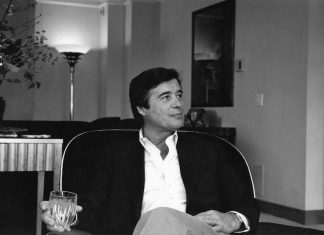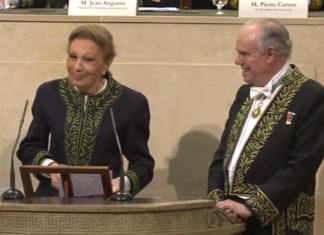By Cyrus Kadivar
[aesop_content color=”#ffffff” background=”#0892d0″ columns=”1″ position=”none” imgrepeat=”no-repeat” disable_bgshading=”off” floaterposition=”left” floaterdirection=”up” revealfx=”off” overlay_revealfx=”off” aesop-generator-content=”Mehrdad Pahlbod — who died three years ago this month — was for 51 years the husband of Princess Shams, the sister of Mohammad Reza Shah. The couple had three children. Between 1964 and 1978, Mr. Pahlbod served as Iran’s Minister of Culture and the Arts. After the Revolution, he and his family settled in the United States. Late in life, Mr. Pahlbod dictated his memoirs to the California-based author, producer and Universal Studios development executive Jerry Green. “Devotion: A Memoir of Mehrdad Pahlbod” was published a year after Mr. Pahlbod passed away at the age of 100. To mark the anniversary of Mr. Pahlbod’s passing, Kayhan Life recently interviewed Mr. Green about the experience of writing the memoir.
“]Mehrdad Pahlbod — who died three years ago this month — was for 51 years the husband of Princess Shams, the sister of Mohammad Reza Shah. The couple had three children. Between 1964 and 1978, Mr. Pahlbod served as Iran’s Minister of Culture and the Arts.
After the Revolution, he and his family settled in the United States. Late in life, Mr. Pahlbod dictated his memoirs to the California-based author, producer and Universal Studios development executive Jerry Green. “Devotion: A Memoir of Mehrdad Pahlbod” was published a year after Mr. Pahlbod passed away at the age of 100.
To mark the anniversary of Mr. Pahlbod’s passing, Kayhan Life recently interviewed Mr. Green about the experience of writing the memoir.
[/aesop_content]
[aesop_image img=”https://kayhanlife.com/wp-content/uploads/2021/08/PHOTO-5P-scaled.jpg” panorama=”off” credit=”Jerry Green in 2021 with copies of DEVOTION. Courtesy of Jerry Green” align=”center” lightbox=”off” captionsrc=”custom” captionposition=”center” revealfx=”off” overlay_revealfx=”off”]
How did you approach the story of this distinguished Iranian gentleman in exile?
Honestly, with fear and trepidation. I wasn’t sure I could write it. I had limited knowledge of Iran and of the cultural icon, Mehrdad Pahlbod. Simple things concerned me, like: how should I address him? But he made it easy, calling me Jerry and I calling him Mehrdad.
Did you have any prior knowledge of your subject before meeting him?
His daughter, Shahrazad, mentioned him, but nothing more. When her American husband (a good friend of mine) approached me on her father’s behalf to see if I would write his story, I agreed, thinking the project would take six months.
I was wrong! After our first meeting, I realized the magnitude of the story, which ended up taking almost two years to complete. It was certainly worth it!
Mehrdad was 98 years old when we met. He still possessed a keen sense of wit, and I sensed at once that I was in the presence of a great man.
[aesop_image img=”https://kayhanlife.com/wp-content/uploads/2021/08/PHOTO-4P-scaled.jpg” panorama=”off” credit=”Mehrdad Pahlbod with Shahrazad, Shahryar, and Shahbaz (Los Angeles, 2005). Photo Credit: With Permission and Courtesy of the Pahlbod Family.” align=”center” lightbox=”off” captionsrc=”custom” captionposition=”center” revealfx=”off” overlay_revealfx=”off”]
Do you recall your first encounter?
Yes. We sat at the dining room table and chatted, he sizing me up and I thinking, can I do justice to this highly refined man’s story? Other stories I’ve written are for the most part fiction, with a little truth thrown in. But now I was faced with the story of a real-life hero that required truth and accuracy. Perhaps my first impression when meeting this Persian icon was intimidation — something we guys don’t always like to admit.
How much did you know about Iran when you started?
I knew very little about Iran, except that the Shah had been overthrown by an Ayatollah. But I soon gained from Mehrdad a fuller understanding of Iran’s past and rich cultural heritage. The project required a lot of research. Mehrdad would mention a name or event that prompted me to dig further to understand time and culture.
Can you describe the daily writing routine you established with Mr. Pahlbod?
My writing routine is pretty consistent regardless of what I’m writing. I do most of my writing at the local coffee house. However, when hearing and recording Mehrdad’s story, I went to see him on many occasions.
We always met at his home in California. Shahrazad bought two recording devices that we used, and then the following day she or I would transcribe the recordings. After writing 20 pages or so I emailed them to Mehrdad for his corrections and approval.
What was so special about this man’s life?
Mehrdad had the ability to lead and follow, be assertive and yet unassuming, demonstrate love but with firmness, hold to a structure and yet be flexible. He was a student of life – and what a life! I mean, how many people rise from a middle-class environment to interact with royalty, dine with presidents and Hollywood elites, and then when those days fade away are still humble, cheerful, and hopeful? His face would light up when he relived the greatest times in his life … and there were so many!
How did Mehrdad Pahlbod meet Princess Shams?
Their love is the kind of story movies are made of. I’m surprised that Hollywood hasn’t snatched it up.
Princess Shams’s aunt invited Mehrdad and his two handsome brothers to tea at the princess’s villa. It was enchanting to see Mehrdad’s personality become effervescent when describing his vision of first seeing her. “She was beautiful, radiant, glowing, resplendent, and so many other words that describe beauty and perfection,” he would say.
[aesop_image img=”https://kayhanlife.com/wp-content/uploads/2021/08/PHOTO-1P.jpg” panorama=”off” credit=”Mehrdad Pahlbod and Princess Shams, Tehran, 1950s. Photo Credit: With Permission and Courtesy of the Pahlbod Family.” align=”center” lightbox=”off” captionsrc=”custom” captionposition=”center” revealfx=”off” overlay_revealfx=”off”]
Mehrdad wasn’t, in fact, Princess Shams’s first husband.
Correct. In 1937 she married Fereydoun Djam, a groom chosen by her father, Reza Shah. It was a loveless match. Reza Shah refused to let them divorce. However, in 1944, before he died in exile, the old man did grant permission for the divorce.
After the war, Mehrdad and Princess Shams married and honeymooned in Cairo before starting a family in America.
The couple had three children: Shahbaz, Shahryar, and Shahrazad. When it was time to give birth, they would travel 12,000 miles to Los Angeles so the children could be delivered by the doctor Princess Shams loved, one recommended by Rita Hayworth.
[aesop_image img=”https://kayhanlife.com/wp-content/uploads/2021/08/PHOTO-2P-scaled.jpg” panorama=”off” credit=”Princess Shams and her three young children in Iran (1956). Photo Credit: With Permission and Courtesy of the Pahlbod Family.” align=”center” lightbox=”off” captionsrc=”custom” captionposition=”center” revealfx=”off” overlay_revealfx=”off”]
Did the Princess and her husband have many Hollywood friends?
They did. They became friends with many Hollywood celebrities while living in Beverley Hills. Their friend Hermes Pan, a Hollywood icon of choreography, introduced them to Rita Hayworth, the biggest star of her day. Other Hollywood acquaintances included Debbie Reynolds, Fred Astaire, Lloyd Bridges, Adam West, Helen Hayes, and Ann Miller. But their closest relationship was with Loretta Young, a lifelong friend and godmother to the children.
How did Mr. Pahlbod start his career?
One day, sometime after Mehrdad moved to Iran and while he was at the Queen Mother’s palace, Mohammed Reza Shah casually said to him: “Pahlbod,” (the Shah always called him Pahlbod), “why don’t you take the job of overseeing the arts? There isn’t a lot of money in the arts, so no one will try to take it from you.” And with that rather encouraging invitation, Mehrdad took the leadership of the Culture and Arts Ministry. From that humble beginning he grew it into an organization never imagined.
What were your subject’s greatest achievements in Iran?
Mehrdad achieved so much in the field of culture and the arts, but he always remembered a special project he spearheaded called the “Night of Prayer for the Shah,” a nationwide event. It was his favourite achievement.
A close second was the 1967 opening of the Roudaki Hall complex during the Shah’s Coronation Ceremony. Mehrdad’s eyes would sparkle when describing the event.
His influence was enormous, taking an organization with no budget and very little respect and growing it into a ministry that touched the nation and the world, including Hollywood. He interacted with prime ministers, presidents, producers, and movie stars. Mehrdad was bigger than any one project. He was national, even international.
Describe his relationship with his brother-in-law, the Shah of Iran.
Mehrdad maintained a professional respect for the Shah as head of state, oftentimes settling for less than other cabinet members. His department was not highly regarded in government circles at first. He did all of that with honor and dignity because, as I often say, Mehrdad was Mehrdad.
Was he devoted to Mohammed Reza Shah?
Mehrdad’s loyalty to the Shah stands as a prime example of service, honor, and respect. His loyalty wasn’t only because he was related to the king. Foremost in his efforts was Mehrdad’s love for all that was Iran. He shared the Shah’s devotion to his country.
Did Princess Shams have an official role in Pahlavi Iran?
Princess Shams cared deeply for the Red Lion and Sun, Iran’s equivalent of the Red Cross, where she served for many years as chair and benefactor. She also loved animals, and Mehrdad accepted that, even when it included wild animals. Their home life at the Pearl Palace (designed by the Frank Lloyd Wright Foundation) included twelve dogs, chimps, peacocks, exotic birds, and a cheetah given to them by the president of Kenya.
[aesop_image img=”https://kayhanlife.com/wp-content/uploads/2021/08/PHOTO-3P.jpg” panorama=”off” credit=”Portrait of HRH Princess Shams by Artis Lane (1980). Photo Credit: With Permission and Courtesy of the Pahlbod Family.” align=”center” lightbox=”off” captionsrc=”custom” captionposition=”center” revealfx=”off” overlay_revealfx=”off”]
Then came the Iranian Revolution. How did Mr. Pahlbod view that episode?
Mehrdad would say that the 1979 upheaval was not a revolution but a revolt, bringing destruction and mayhem. The Princess and Mehrdad were in the United States when it happened. His request to return was denied by the Shah, saying it was too dangerous. He did finally return to check on his staff and assure the department was still functioning properly. But Khomeini’s supporters didn’t care about culture and fine arts. Lawlessness overran the country and he had to leave.
How did Mr. Pahlbod and Princess Shams cope in exile?
In January 1979, groups of paid protestors set fire to their home in Los Angeles, forcing them to flee, along with the invalid Queen Mother. They lived the remainder of their lives in California. Through it all, Mehrdad continued caring for his wife as the Princess she had always been.
He was forced to make compromises to provide the lifestyle she grew up knowing. She was a princess, daughter of Reza Shah Pahlavi, the Cossack brigadier who, as king, rescued declining Persia from a feudal society and set it on a course of greatness and modernity.
What happened to Princess Shams?
After battling heart disease and cancer for many years, Princess Shams died in February 1996 at age 77. To Mehrdad, there was nothing more to live for. But Mehrdad’s children “circled the wagons” with strength and comfort after his wife’s passing.
How did Mr. Pahlbod spend his twilight years?
Fortunately Mehrdad’s final years proved joyful. After prolonged grieving, he met a Persian lady of compassion, comfort, and someone to offer him devotion.
Did he see the book finished?
A week after finishing the first draft, Mehrdad Pahlbod entered the hospital and remained there until August 8, 2018, when he too passed into the pages of history.
How will you remember Mr. Pahlbod?
I trust he will forever be remembered as a man of character, lived out in humility.






Thank you for a great interview and introducing Mr. Green’s book to a wider audience. Your continued work on reminding the current and past generations of the Iranians about past luminaries who shaped modern Iran and why the current generation has stubbornly refused to accept outdated and rococo values forced on them by the mullahs is a testament to your dogged pursuit of all that was and is good about Iran. I will look for the book.